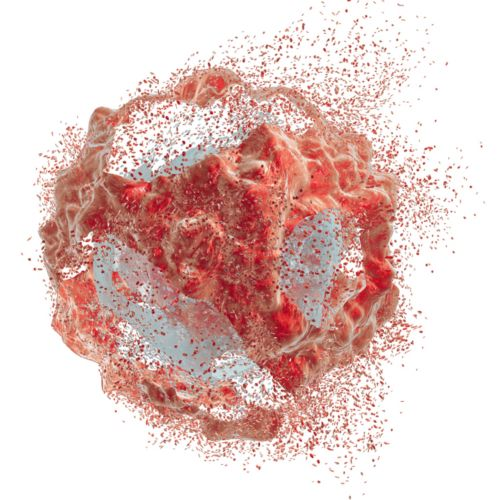😱Emergencies in Hematolo...

Highlights
- 😱Emergencies in hematology😱
Tumor lysis syndrome (TLS)
A short 🧵 #MedTwitter
1/19
 (View Tweet)
(View Tweet)
- What's TLS?
-major comorbidity in the management of hematologic malignancies and one of the major conditions young colleagues should
👉know to detect and to handle❗️
-modern definition of TLS is based on the Cairo–Bishop criteria for laboratory and clinical TLS
2/19
 (View Tweet)
(View Tweet)
- Clinical TLS:
-simply defined as laboratory TLS with the addition of an elevated creatinine not attributable to
- History:
-phenomenon of chemotherapy-induced TLS became apparent soon after effective therapies for leukemia and lymphoma were discovered early in 20th century
-several reports published describing uric acid nephropathy and acute failure within days after treatment
4/19
 (View Tweet)
(View Tweet)
- Pathogenesis I:
-lysis of tumour cells👉release of cell contents, incl electrolytes, proteins and nucleic acids
- nucleic acid and protein contents are quickly broken down in the liver👉production of uric acid
 (View Tweet)
(View Tweet)
- Pathogenesis II:
-release of potassium & phosphorus
-rapid increases in potassium, sometimes potentiated by renal failure👉arrhythmias -hypocalcaemia (Ca2+ phosphorus precipitation & tissue deposition)👉muscle cramps, tetany, arrhythmias, seizures
6/19
 (View Tweet)
(View Tweet)
- Pathogenesis III:
-mechanism behind acute injury is multi-factorial -hyperuricemia👉direct crystallization within renal tubules
-uric acid-induced renal vasoconstriction tissue hypoxia, reperfusion injury & local inflammation
7/19
 (View Tweet)
(View Tweet)
- Risk stratification:
-serum creatinine, arrhythmia and/or seizures, with the most severe clinical sequela determining the grade
BUT
-expert opinion, not validated prospectively
-acute failure >50% but only ~1% show seizures
8/19
 (View Tweet)
(View Tweet)
- In general:
-severity of TLS may depend on the cancer mass, potential for lysis of tumor cells, characteristics of the patient and supportive care
-the greater the cancer mass, the greater the quantity of cellular contents released after anticancer therapy
9/19 https://t.co/BW4h314zG9 (View Tweet)
- Patient history matters!
-perhaps a more clinically relevant is identification of patients at highest risk
-CML considered low-risk, as is CLL
BUT
iCLL classified as intermediate-risk if WBC >50×10^9/l or if treated with targeted therapies such as venetoclax
10/19
 (View Tweet)
(View Tweet)
- Drug-associated TLS (selection):
-all anti-CD20 monoclonal antibody therapies
-ibrutinib, lenalidomide, pazopanib, trastuzumab
-venetoclax (ramp-up!)
-paclitaxel, radiation, corticosteroids, fludarabine, immune checkpoint inhibitors...
11/19
 (View Tweet)
(View Tweet)
- Prevention:
-CRITICAL
-hydration is backbone for prevention/treatment
-
- goal: improve volume status and create the optimal environment forexcretion of uric acid and phosphate
-
- rules of 👍 i~3 l/m2/day or targeting urine output of at least 100–150 ml/h
12/19
 (View Tweet)
(View Tweet)
- Controversy "urine alkalization":
-may prevent uric acid crystal formation
BUT
-can ⬇️xanthine solubility👉promote crystal formation
-can ⬆️Ca2+ phosphate precipitates
-allopurinol can lead to xanthinuria
-alkalization+allopurinol not currently recommended
13/19 https://t.co/UTfXf2tHRL (View Tweet)
- Allopurinol:
-xanthine oxidase inhibitor
- -⬇️serum uric acid levels
-
- ⬇️risk of uric acid crystallization and acute renal failure
-recommended: daily for adults 600–800 mg (into 2–3 doses)
-lower dose eg 300 mg often utilized
-started 1–2 days prior to chemo + hydration
14/19
 (View Tweet)
(View Tweet)
- Rasburicase:
-recombinant urate oxidase
-converting uric acid to allantoin
-rapid and high efficacy (median 1 day)
BUT
-no randomized trial showed superiority vs allopurinol
-recommended for high risk
-general practice: if the baseline uric acid is >8 mg/dl
15/19
 (View Tweet)
(View Tweet)
- CAVE:
-patients with glucose-6-phosphate dehydrogenase deficiency (G6PD) are at risk for acute haemolytic anaemia after administration of rasburicase
-FDA recommends performing G6PD enzyme activity testing in patients at higher risk for G6PD deficiency
16/19
 (View Tweet)
(View Tweet)
- Febuxostat:
-another oral xanthine oxidase inhibitor
-pharmacologic advantage over allopurinol: inhibits both oxidized+reduced form of xanthine oxidase👉potency⬆️ and no need for dose adjustment in renal failure
BUT
-FLORENCE trial showed NO difference to allopurinol
17/19
 (View Tweet)
(View Tweet)
- Prognosis:
-often not the principle cause of mortality (infections, sepsis!)
-eg in AML, only ~5% show clinical TLS
BUT
👉 associated with a much higher death rate (~70% vs 25% for laboratory)
-adapt for risk and patient characteristics❗️
18/19 https://t.co/UmHoCVlnU4 (View Tweet)
- TLS summary:
❗️Emergency
❗️Monitor: lab+clinical (🫘 failure, 🫀arrhythmias, seizures)
❗️Risk stratify: disease, morbidity, treatment
❗️Secure venous access
❗️Prevention/treatment: HYDRATION, allopurinol for lower and +rasburicase for higher risk
#MedTwitter https://t.co/G5j6j6ZeWj (View Tweet)
- References & resources:
https://t.co/HDvz3pTngD
https://t.co/nBnTcTTQVp
https://t.co/oDUJqIWf2H
https://t.co/rgtKgkiyuL https://t.co/R1G9Lb8ZPj (View Tweet)

 (View Tweet)
(View Tweet) (View Tweet)
(View Tweet) (View Tweet)
(View Tweet) (View Tweet)
(View Tweet) (View Tweet)
(View Tweet) (View Tweet)
(View Tweet) (View Tweet)
(View Tweet) (View Tweet)
(View Tweet) (View Tweet)
(View Tweet) (View Tweet)
(View Tweet) (View Tweet)
(View Tweet) (View Tweet)
(View Tweet) (View Tweet)
(View Tweet) (View Tweet)
(View Tweet)